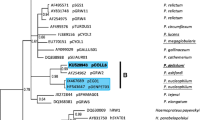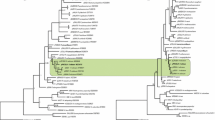Abstract
Literature data on toucans haemosporidians are scarce and all reports come from investigations in Brazil. Muniz et al. (Rev Bras Malariol 3: 339–356, Muniz et al., Rev Bras Malariol 3:339–356, 1951) and Muniz and Soares (Rev Bras Malar 611–617, Muniz J, Soares R de RL (1954) Nota sôbre um parasita do gênero Plasmodium encontrado no Ramphastos toco Müller, 1776, “Tucano-Açu”, e diferente do Plasmodium huffi: Plasmodium pinottii n. sp. Rev Bras Malar 611 – 617.) described two Plasmodium species, P. huffi and P. pinottii, in Ramphastos toco. Later, Manwell and Sessler (J Protozol 18: 570–574, Manwell and Sessler, Malaria Parasites of Toucans J Protozol 18:570–574, 1971) established a new subspecies, P. nucleophilum toucani. In the last review on avian haemosporidians, Valkiūnas (Valkiūnas, Avian malaria parasites and other haemosporidia, CRC Press, New York, 2005) highlighted that P. huffi was insufficiently characterized, considering it a lost lineage. Also, the original description of P. huffi was considered insufficiently clear, due to a possible co-infection of the toucan hosts with a Novyella-like species. Here, we redescribed the species Plasmodium (Huffia) huffi based on morphological and molecular data, which were found in two toucan species, Ramphastos toco and Pteroglossus aracari from Brazil. Morphological features of the specimens are markedly the same as the original description. In R. toco, we observe two individuals infected, one infected only with P. huffi and one co-infected with P. huffi and the Novyella-like species, as observed in the original description. Also, we observe one R. toco infected only with the Novyella-like species, identified by morphological and molecular data as Plasmodium (Novyella) nucleophilum nucleophilum. In this way, it was possible to redescribe Plasmodium huffi in detail, without the doubt characters observed in the original description. Moreover, by applying species delimitation algorithms to a large Plasmodium phylogeny, we were able to identify new possible hosts for P. huffi and extend its geographic distribution to include North America.



Similar content being viewed by others
References
Bennett GF, Campbell AG (1972) Avian Haemoproteidae. I. Description of Haemoproteus fallisi n. sp. and a review of the haemoproteids of the family Turdidae. Can J Zool 50:1269–1275. https://doi.org/10.1139/z72-172
Bensch S, Stjernman M, Hasselquist D, Ostman O, Hansson B, Westerdahl H, Pinheiro RT (2000) Host specificity in avian blood parasites: a study of Plasmodium and Haemoproteus mitochondrial DNA amplified from birds. P Roy Soc B Biol Sci 267:1583–1589. https://doi.org/10.1098/rspb.2000.1181
Bush AO, Lafferty KD, Lotz JM, Shostak AW (1997) Parasitology meets ecology on its own terms: Margolis et al. revisited. J Parasitol 83:575–583. https://doi.org/10.2307/3284227
Fecchio A, Chagas CRF, Bell JA, Kirchgatter K (2020) Evolutionary ecology, taxonomy, and systematics of avian malaria and related parasites. Acta Trop 204:105364. https://doi.org/10.1016/j.actatropica.2020.105364
Galen SC, Borner J, Martinsen ES, Schaer J, Austin CC, West CJ, Perkins SL (2018a) The polyphyly of Plasmodium: comprehensive phylogenetic analyses of the malaria parasites (order Haemosporida) reveal widespread taxonomic conflict. R Soc Open Sci 5:171780. https://doi.org/10.1098/rsos.171780
Galen SP, Nunes R, Sweet PR, Perkins L (2018b) Integrating coalescent species delimitation with analysis of host specificity reveals extensive cryptic diversity despite minimal mitochondrial divergence in the malaria parasite genus Leucocytozoon. BMC Evol Biol 18:128. https://doi.org/10.1186/s12862-018-1242-x
Garnham PCC (1966) Malaria parasites and other haemosporidia. Blackwell Sci. Pub, Oxford
Godfrey RD, Fedynich AM, Pence DB (1987) Quantification of hematozoa in blood smears. J Wildl Dis 23:558–565. https://doi.org/10.7589/0090-3558-23.4.558
Hellgren O, Waldenström J, Bensch S (2004) A new PCR assay for simultaneous studies of Leucocytozoon, Plasmodium and Haemoproteus from avian blood. J Parasitol 90:797–802. https://doi.org/10.1645/GE-184R1
Hernández-Lara C, de Los Monteros AE, Ibarra-Cerdeña CN, García-Feria L, Santiago-Alarcon D (2018) Combining morphological and molecular data to reconstruct the phylogeny of avian Haemosporida Int J Parasitol 48(14):1137–1148. https://doi.org/10.1016/j.ijpara.2018.10.002
Huff CG (1953) Observations on Plasmodium huffi Muniz, Soares, and Batista. Am J Trop Med Hyg 2:620–623
Kapli P, Lutteropp S, Zhang J, Kobert K, Pavlidis P, Stamatakis A, Flouri T (2017) Multi-rate Poisson tree processes for single-locus species delimitation under maximum likelihood and Markov chain Monte Carlo. Bioinformatics 33:1630–1638. https://doi.org/10.1093/bioinformatics/btx025
Katoh K, Rozewick J, Yamada KD (2019) MAFFT online service: multiple sequence alignment, interative sequence choice and visualization. Brief Bioinformatics 20:1160–1166. https://doi.org/10.1093/bib/bbx108
Kumar S, Stecher G, Li M, Knvaz C, Tamura K (2018) MEGA X: molecular evolutionary genetic analysis across computing platforms. Mol Biol Evol 35:1547–1549. https://doi.org/10.1093/molbev/msy096
Manwell RD, Sessler GJ (1971) Malaria Parasites of Toucans J Protozol 18:570–574
Martinsen ES, Perkins SL, Schall JJ (2008) A three-genome phylogeny of malaria parasites (Plasmodium and closely related genera): evolution of life-history traits and host switches. Mol Phylogenet Evol 47:261–273. https://doi.org/10.1016/j.ympev.2007.11.012
Muniz J, Soares R de RL (1954) Nota sôbre um parasita do gênero Plasmodium encontrado no Ramphastos toco Müller, 1776, “Tucano-Açu”, e diferente do Plasmodium huffi: Plasmodium pinottii n. sp. Rev Bras Malar 611–617
Muniz J, Soares R, Batista S (1951) On a new species of Plasmodium parasite of the Ramphastos toco Müller, 1776. Plasmodium huffi n. sp. Rev Bras Malariol 3:339–356
Oliveira L, Dias RJP, Rossi MF, D’Agosto M, Santos HA (2020) Molecular diversity and coalescent species delimitation of avian haemosporidian parasites in an endemic bird species of South America. Parasitol Res 119:4033–4047. https://doi.org/10.1007/s00436-020-06908-9
Perkins SL (2014) Malaria’s many mates: past, present, and future of the systematics of the order Haemosporida. J Parasitol 100:11–25. https://doi.org/10.1645/13-362.1
R Core Team (2020) R: A language and environment for statistical computing. R Foundation for Statistical Computing, Vienna
Ronquist F, Teslenko M, Mark PVD, Ayres DL, Darling A, Höhna S, Larget B, Liu L, Suchard MA, Huelsenbeck JP (2012) MrBayes 3.2: efficient Bayesian phylogenetic inference and model choice across a large model space. Syst Biol 61:539–542. https://doi.org/10.1093/sysbio/sys029
Sick H (1997) Ornitologia brasileira. Nova Fronteira, Rio de Janeiro
Valkiūnas G (2005) Avian malaria parasites and other haemosporidia. CRC Press, New York
Valkiūnas G, Palinauskas V, Ilgūnas M (2014) Molecular characterization of five widespread avian haemosporidian parasites (Haemosporida), with perspectives on the PCR-based detection of haemosporidians in wildlife. Parasitol Res 113:2251–2263. https://doi.org/10.1007/s00436-014-3880-2
Valkiūnas G, Iezhova TA, Križanauskienė A, Palinauskas V, Sehgal RNM, Bensch S (2008) A comparative analysis of microscopy and PCR-based detection methods for blood parasites. J Parasitol 94:1395–1422. https://doi.org/10.1645/GE-7343547RN.1
Zhang J, Kapli P, Pvlidis P, Stamatakis A (2013) A general species delimitation method with applications to phylogenetic placements. Bioinformatics 29:2869–2876. https://doi.org/10.1093/bioinformatics/btt499
Funding
This work was supported by Coordenação de Aperfeiçoamento de Pessoal de Nível Superior (CAPES), Brazil [grant number 1525/2011], and Fundação de Amparo à Pesquisa do Estado de Minas Gerais (FAPEMIG) (PPM2016, grant number PPM-00734–16), Brazil.
Author information
Authors and Affiliations
Corresponding author
Ethics declarations
Conflict of interest
The authors declare no competing interests.
Additional information
Section Editor: Tobili Sam-Yellowe
Publisher’s note
Springer Nature remains neutral with regard to jurisdictional claims in published maps and institutional affiliations.
Supplementary Information
Below is the link to the electronic supplementary material.
Rights and permissions
About this article
Cite this article
Cedrola, F., Martinele, I., Senra, M.V.X. et al. Rediscovery of Plasmodium (Huffia) huffi (Apicomplexa, Haemosporida): a lost lineage from toucans. Parasitol Res 120, 3287–3296 (2021). https://doi.org/10.1007/s00436-021-07273-x
Received:
Accepted:
Published:
Issue Date:
DOI: https://doi.org/10.1007/s00436-021-07273-x




